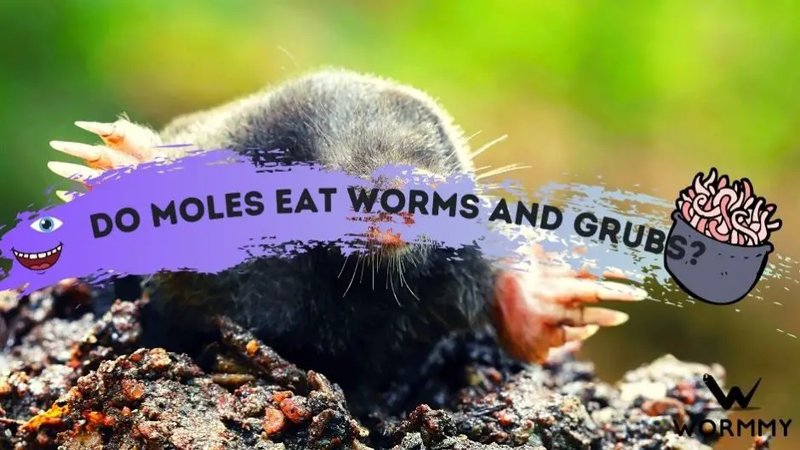
Imagine your yard as a restaurant. Moles are the diners, while grub worms are the delicious appetizers that attract them. If the grub worms are abundant, the moles are sure to show up for dinner. In this article, we’re going to unravel the relationship between these two creatures, so you can better manage your garden and protect your precious plants. Let’s dive into this fascinating connection!
What Are Moles?
Moles are small, burrowing mammals that are often found in gardens and lawns. They have velvety fur, spade-like hands, and tiny eyes, which help them navigate through the soil. You might be wondering why they dig so much. Well, moles are primarily after their food—soil-dwelling insects, worms, and yes, grub worms!
These critters are nocturnal, so you won’t typically see them during the day. Instead, they make their presence known through the tunnels they dig and those telltale dirt mounds on your lawn. While they can be beneficial for soil aeration, they do have a knack for uprooting plants in search of their next meal.
Identifying Moles in Your Yard
If you suspect moles are taking over your yard, look for these signs:
- Dirt Mounds: These small, volcano-like piles of dirt are usually a sure sign of moles. They dig tunnels close to the surface, pushing up dirt as they go.
- Tunnels: If you see raised ridges in your lawn, that’s likely a mole tunnel. These can be a bit tricky to spot, but they’ll disrupt the smooth appearance of your yard.
- Displaced Soil: Look for soft spots in your yard where the soil feels loose. This can indicate a tunneling system just beneath the surface.
Understanding how to identify moles can help you address any issues they cause before they escalate.
What Are Grub Worms?
Grub worms, on the other hand, are the larvae of beetles. They live underground and thrive in healthy soil, which makes them pretty common in gardens. These little worms typically have a C-shaped body, are white or cream-colored, and have a brown head. Just like moles, they prefer a nice, moist environment to hang out in, which is often the soil of your lawn or garden.
Now, you might be thinking, “Are grub worms really that bad?” They aren’t inherently harmful, but they can cause a lot of damage, especially when they’re in large numbers. They feed on the roots of grass and other plants, which can lead to wilting and even death of your beloved greenery.
How Grub Worms Damage Your Yard
Here’s how grub worms can wreak havoc in your garden:
- Root Damage: As they munch on root systems, plants struggle to absorb nutrients and water, leading to poor growth or even death.
- Lawn Patches: You may notice brown patches in your yard where the grass has died, leaving behind unsightly bald spots. This is often a sign of grub infestation.
- Pest Attraction: Healthy grass attracts moles, and if your yard is full of grub worms, it’s like an all-you-can-eat buffet for those furry little diggers.
So, keeping an eye on grub worm populations is important if you want to maintain a thriving garden.
How Moles and Grub Worms Are Connected
The relationship between moles and grub worms is pretty straightforward. Grub worms provide a primary food source for moles. When moles find a nice stash of grub worms in your yard, it’s similar to discovering a treasure trove.
Moles will dig in search of these larvae, often causing damage to your lawn while they’re at it. Since grub worms thrive in well-watered areas, a lush garden can attract both these pests. Essentially, a mole’s presence is often a direct reflection of the grub worm population lurking beneath the soil.
Impact on Lawn Health
When the balance of these two creatures gets out of whack, it can lead to significant issues for your lawn. If your grass is lush and green, it can attract more grub worms, which in turn draws in more moles. This cycle can lead to:
- Extreme Tunneling: Moles digging everywhere can leave your yard looking like a war zone.
- Plant Damage: As moles tunnel, they can uproot plants and cause soil disruption, leading to a decline in your garden’s health.
- Increased Pest Activity: More moles mean more digging and disturbance, which can invite other pests into the mix.
It’s vital to manage both moles and grub worms to maintain a healthy lawn.
How to Manage Moles and Grub Worms
Dealing with moles and grub worms can feel daunting, but there are several things you can do to manage their populations. Here are some strategies:
- Grub Control: Use specialized treatments or natural predators to manage grub worm populations. This can help reduce the food supply for the moles.
- Physical Barriers: Installing underground barriers can deter moles from invading certain areas of your garden.
- Plant Resistant Varieties: Some plants are less appealing to grub worms. Consider including these in your garden to keep their numbers down.
- Trapping Moles: If moles become a serious issue, you might need to resort to trapping them. There are humane options available that let you relocate the creatures.
Finding the right balance between protecting your plants and managing these creatures can take some effort.
Understanding the connection between moles and grub worms is key to keeping your garden healthy. With moles often following the food chain to grub worms, tackling the latter can help manage the former. You can protect your lawn by controlling grub populations, using barriers, and planting resistant species.
At the end of the day, it’s all about creating a harmonious environment for your garden. By managing both moles and grub worms wisely, you can preserve the beauty of your space while minimizing any pesky disruptions. Think of it like running a well-oiled machine; every part needs to work smoothly together. Happy gardening!

